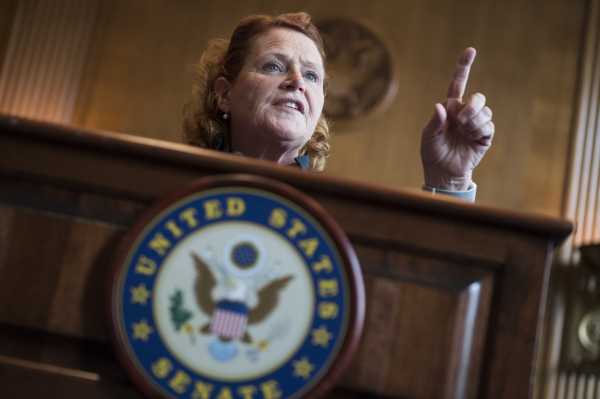
It sure looks like Republicans in North Dakota are trying to suppress Native American voters.
Previously, the US Supreme Court allowed a lower court ruling that lets the state enforce its voter ID requirement. The rule asks voters to present a current residential address to vote, but Native Americans living on a reservation — potentially thousands who are more likely to vote Democrat — don’t have a typical residential address, instead relying on PO boxes. That could stop them from voting.
As Maggie Astor reported for the New York Times, Republicans in the state started to consider the law shortly after the surprising victory of Democratic Sen. Heidi Heitkamp in 2012. The win relied in large part on Native Americans, who are 30,000 strong in North Dakota. Heitkamp won in 2012 by fewer than 3,000 votes.
Astor reported on some other problems too:
Supporters of the voter ID law and other hurdles to the ballot argue that they’re necessary to prevent voter fraud. This is typical across the US: Fears of voter fraud have been used to justify all sorts of new Republican-approved restrictions on voting.
But there’s zero evidence that widespread voter fraud is a real problem. And as seems to be true in North Dakota, voting restrictions enacted by Republicans appear to be geared more toward preventing minority voters — who more often vote for Democrats — from casting a ballot.
The good news, if there is any, is that some groups in North Dakota think anger at the voting restrictions may spur more people to vote, at least in the 2018 elections. North Dakota’s tribes have also poured resources into getting legitimate IDs to as many voters as possible.
“I’m past the point of being upset over it,” Lonna Jackson-Street, secretary and treasurer of the Spirit Lake Tribe, told the Times. “I’m more excited about the outcome, because I think we’re going to bring in numbers that we’ve never seen before.”
Voter suppression or not, Heitkamp’s chances don’t look good. Polling in North Dakota’s Senate race is very limited, but the RealClearPolitics average of polls suggests that her Republican opponent, Kevin Cramer, is ahead by more than 12 points — which is far more than the estimated impact of voter ID laws and similar restrictions, based on the research. But there have been surprises in North Dakota before, and a narrow loss by Heitkamp could very well be blamed on new voter suppression tactics.
Republicans are creating more barriers to the voting booth
According to the Brennan Center for Justice, 24 states, predominantly controlled by Republicans, have enacted new voting restrictions since 2010: “13 states have more restrictive voter ID laws in place (and six states have strict photo ID requirements), 11 have laws making it harder for citizens to register, seven cut back on early voting opportunities, and three made it harder to restore voting rights for people with past criminal convictions.”
Since the 2016 election in particular, Arkansas and North Dakota approved new voter ID laws. Missouri has implemented new voting restrictions that were approved by voters via ballot in 2016. And several other states — Georgia, Iowa, Indiana, and New Hampshire — passed new restrictions on top of those they had before, according to Brennan.
Republican supporters of the restrictions argue that they’re meant to prevent voter fraud. For example, a photo ID requirement is supposed to make it more difficult for someone to impersonate another voter on Election Day.
But voter fraud is extremely rare in the US.
Loyola Law School professor Justin Levitt studied voter impersonation. He found 35 total credible accusations between 2000 and 2014, constituting a few hundred ballots at most. During this 15-year period, more than 800 million ballots were cast in national general elections and hundreds of millions more were cast in primary, municipal, special, and other elections.
A 2012 investigation by the News21 journalism project looked at all kinds of voter fraud nationwide, including voter impersonation, people voting twice, vote buying, absentee fraud, and voter intimidation. It confirmed that voter impersonation was extremely rare, with just 10 credible cases.
But the other types of fraud weren’t common either: In total, the project uncovered 2,068 alleged election fraud cases from 2000 through part of 2012, covering a time span when more than 620 million votes were cast in national general elections alone. That represents about 0.000003 alleged cases of fraud for every vote cast and 344 fraud cases per national general election, in each of which between 80 million and 135 million people voted. The number of fraudulent votes was a drop in the bucket.
What’s more, not all — maybe not even half — of these alleged fraud cases were credible, News21 found: “Of reported election-fraud allegations in the database whose resolution could be determined, 46 percent resulted in acquittals, dropped charges or decisions not to bring charges.”
This has made Democrats very suspicious of Republicans’ push for more voting restrictions.
Studies suggest that the voting requirements Republicans have pursued disproportionately hurt minority voters who are more likely to elect Democrats. A widely cited 2006 study by the Brennan Center found voter ID laws, for instance, disproportionately impacted eligible black voters: 25 percent of black voting-age citizens did not have a government-issued photo ID, compared with 8 percent of white voting-age citizens. And a study for the Black Youth Project, which analyzed 2012 voting data for people ages 18 to 29, found 72.9 percent of young black voters and 60.8 percent of young Hispanic voters were asked for IDs to vote, compared with 50.8 percent of young white voters.
One reason for these kinds of numbers is disparate enforcement. Polling officials, perhaps driven by racial biases, appear more likely to ask minority voters for an ID.
But minority voters are also generally hit harder by voter ID laws and other restrictions on voting. For example, since minority Americans are less likely to have flexible work hours or own cars, they might have a harder time affording a voter ID or getting to the right place (typically a DMV or BMV office) to obtain a voter ID. And they may rely more on early voting opportunities to cast a ballot, or require a nearby voting place instead of one that’s a drive, as opposed to a walk, away from home or work.
In fact, some Republicans have outright acknowledged that hurting Democratic voters is their goal. As William Wan reported for the Washington Post, following the passage of and court challenges against North Carolina’s controversial law:
So despite claims that this is really about the integrity of elections, enough Republican supporters have slipped in moments of candor to validate Democrats’ suspicions — that this is about stifling the fundamental right to vote for constituents that Republicans don’t typically win.
Will this impact the midterms? It depends how close the races are.
One silver lining for Democrats: The new voting restrictions may not have a huge impact on elections.
That might be surprising, considering all the headlines about voter ID laws in the past few years. A 2012 analysis, for example, found that as many as 758,000 registered voters in Pennsylvania don’t have a photo ID issued by the state’s Transportation Department — meaning that up to 9.2 percent of Pennsylvania voters may have been disenfranchised by a strict photo ID law.
But as Nate Cohn explained in a review of the evidence for the New York Times in 2014, figures like Pennsylvania’s are misleading. He cited a study for the North Carolina Board of Elections:
Essentially, the number of voters who don’t actually have an eligible ID is very inflated by estimates like Pennsylvania’s. And assuming that these people will vote in the first place is a mistake; they’re less likely to vote, with or without a voter ID law.
Cohn added:
As Cohn wrote, a 70-30 skew is still a big loss for Democrats. But when taking into account that many of these people are unlikely to vote in the first place, the total count of lost voters is much smaller than one would think.
Studies looking into voter ID laws’ effect on voter turnout back this up. The research, including multiple studies conducted over several years, has generally found that voter ID laws have little to no impact on voter turnout, even when looking at specific racial groups.
So while voter ID laws probably hit Democratic and minority voters harder than their Republican and white counterparts, we’re really talking about a small effect here. The laws could only swing the closest of elections.
None of the other voting restrictions enacted by states seem to have much of an effect on voting either. For example, researchers have found mixed effects on whether early voting increases turnout, with one study finding that it actually decreased turnout on net if voters couldn’t register to vote and cast their ballot on the same day.
No study has the final word, but the research is generally close enough to suggest that practical barriers to voting have a fairly small effect on whether people actually vote.
The bad news for Democrats is that some of the elections they’re facing in November are expected to be really close. That may include the North Dakota Senate race, although the limited polling suggests not so far. So any impact from voting restrictions could very well decide that state’s race — and therefore control of the Senate — in Republicans’ favor.
Sourse: vox.com






